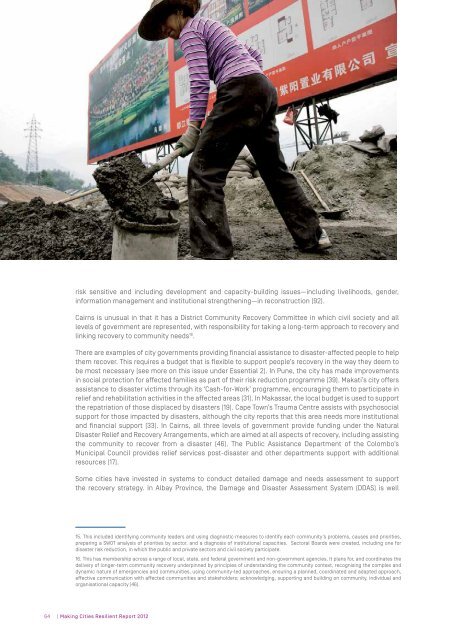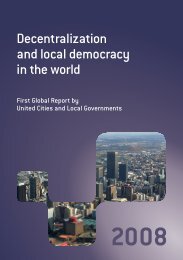Making Cities Resilient Report 2012
Making Cities Resilient Report 2012
Making Cities Resilient Report 2012
Create successful ePaper yourself
Turn your PDF publications into a flip-book with our unique Google optimized e-Paper software.
isk sensitive and including development and capacity-building issues—including livelihoods, gender,<br />
information management and institutional strengthening—in reconstruction (92).<br />
Cairns is unusual in that it has a District Community Recovery Committee in which civil society and all<br />
levels of government are represented, with responsibility for taking a long-term approach to recovery and<br />
linking recovery to community needs 16 .<br />
There are examples of city governments providing financial assistance to disaster-affected people to help<br />
them recover. This requires a budget that is flexible to support people’s recovery in the way they deem to<br />
be most necessary (see more on this issue under Essential 2). In Pune, the city has made improvements<br />
in social protection for affected families as part of their risk reduction programme (39). Makati’s city offers<br />
assistance to disaster victims through its ‘Cash-for-Work’ programme, encouraging them to participate in<br />
relief and rehabilitation activities in the affected areas (31). In Makassar, the local budget is used to support<br />
the repatriation of those displaced by disasters (19). Cape Town’s Trauma Centre assists with psychosocial<br />
support for those impacted by disasters, although the city reports that this area needs more institutional<br />
and financial support (33). In Cairns, all three levels of government provide funding under the Natural<br />
Disaster Relief and Recovery Arrangements, which are aimed at all aspects of recovery, including assisting<br />
the community to recover from a disaster (46). The Public Assistance Department of the Colombo’s<br />
Municipal Council provides relief services post-disaster and other departments support with additional<br />
resources (17).<br />
Some cities have invested in systems to conduct detailed damage and needs assessment to support<br />
the recovery strategy. In Albay Province, the Damage and Disaster Assessment System (DDAS) is well<br />
15. This included identifying community leaders and using diagnostic measures to identify each community’s problems, causes and priorities,<br />
preparing a SWOT analysis of priorities by sector, and a diagnosis of institutional capacities. Sectoral Boards were created, including one for<br />
disaster risk reduction, in which the public and private sectors and civil society participate.<br />
16. This has membership across a range of local, state, and federal government and non-government agencies. It plans for, and coordinates the<br />
delivery of longer-term community recovery underpinned by principles of understanding the community context, recognising the complex and<br />
dynamic nature of emergencies and communities, using community-led approaches, ensuring a planned, coordinated and adapted approach,<br />
effective communication with affected communities and stakeholders; acknowledging, supporting and building on community, individual and<br />
organisational capacity (46).<br />
64 | <strong>Making</strong> <strong>Cities</strong> <strong>Resilient</strong> <strong>Report</strong> <strong>2012</strong>

















